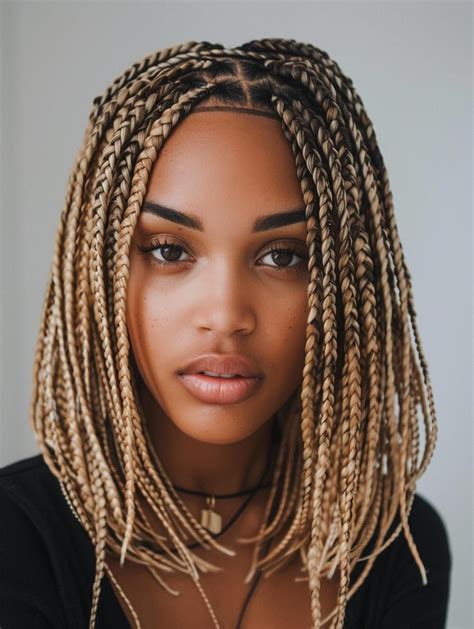Introduction
The world of hair braiding boasts an array of intricate and versatile styles that have captivated individuals for centuries. Among these, micro braids and box braids stand out as two enduringly popular choices, offering a unique blend of aesthetics and practicality. In this comprehensive guide, we will delve into the intricacies of these braiding techniques, exploring their benefits, variations, and application methods.

Understanding the Basics
Micro Braids:
Micro braids, aptly named for their diminutive size, are individual braids that range from 0.5 to 3 millimeters in width. Their creation involves meticulously sectioning the hair into tiny strands, which are then braided tightly against the scalp. Micro braids can be styled in various lengths, ranging from a few inches to waist-length.
Box Braids:
Box braids, also known as cornrows, are characterized by their square or rectangular shape. They consist of three or more strands of hair that are interlaced to form a raised, box-like effect. Box braids can be created in varying sizes, from small to jumbo, and offer a range of styling options.
Benefits of Micro Braids and Box Braids
Versatility:
Both micro braids and box braids offer remarkable versatility, allowing for countless styling possibilities. From sleek buns and ponytails to intricate updos and braids, these techniques provide endless opportunities for self-expression.
Protective Styles:
Micro braids and box braids are highly effective protective styles, safeguarding natural hair from damage caused by heat, chemical treatments, and harsh weather conditions. They promote hair growth, reduce breakage, and minimize tangles.
Scalp Health:
Properly installed micro braids and box braids can contribute to scalp health by allowing air circulation and preventing the buildup of dead skin cells and dirt. This can help prevent scalp irritation and promote a healthy scalp environment.
Low Maintenance:
Once installed, micro braids and box braids require minimal daily maintenance. They can be washed and conditioned with ease, making them a convenient choice for busy individuals. Regular touch-ups are recommended to maintain the desired style.
Types of Micro Braids and Box Braids
Micro Braids:
- Invisible Micro Braids: Designed to be close to the scalp and blend seamlessly with natural hair.
- Butterfly Locs: A variation of micro braids that involves leaving the ends of the braids loose, creating a “butterfly” effect.
- Fulani Braids: A combination of micro braids and beads, often adorned with hair accessories.
Box Braids:
- Small Box Braids: Delicate and intricate, creating a subtle and elegant look.
- Medium Box Braids: A versatile size that offers a balance of style and convenience.
- Jumbo Box Braids: Bold and eye-catching, making a statement with their oversized braids.
Installation Techniques
Micro Braids:
- Manual Braiding: A meticulous process that involves braiding each individual strand of hair by hand.
- Machine Braiding: A quicker method using a braiding machine to automate the braiding process.
Box Braids:
- Traditional Braiding: Using an underhand technique to create the box-like effect.
- Overhand Braiding: An alternative method that creates a raised, “zigzag” pattern.
Duration and Maintenance
The lifespan of micro braids and box braids typically ranges from 6 to 12 weeks, depending on the size, length, and care routine. Regular touch-ups are essential to maintain the desired style and prevent hair damage.
Maintenance Tips:
- Wash and condition braids gently using a sulfate-free shampoo.
- Use a spray bottle to mist braids with water and apply a leave-in conditioner regularly.
- Cover braids with a satin bonnet or scarf at night to prevent friction.
- Avoid excessive heat styling or chemical treatments.
Choosing the Right Style
Selecting the ideal braiding style depends on individual preferences, hair texture, and intended use.
Factors to Consider:
- Hair Thickness: Micro braids are suitable for fine to medium hair, while box braids can accommodate thicker hair textures.
- Styling Versatility: Micro braids offer more versatility for intricate updos, while box braids are ideal for larger, statement-making styles.
- Maintenance: Micro braids require more frequent touch-ups due to their smaller size, while box braids may require less maintenance.
Inspiration and Ideas
The world of micro braids and box braids is a vibrant and dynamic one, with endless possibilities for creativity.
Styling Inspiration:
- Micro Braids: Braided buns, intricate headbands, halo braids, goddess locs
- Box Braids: Majestic updos, statement-making ponytails, geometric patterns, accessorized crowns
Conclusion
Micro braids and box braids continue to captivate hair enthusiasts worldwide, offering a unique blend of style, protection, and practicality. Understanding the intricacies of these techniques empowers individuals to make informed decisions, ensuring they choose the perfect style that aligns with their unique needs and aspirations. Whether seeking a protective style or a bold new look, micro braids and box braids offer a timeless and versatile solution that celebrates the beauty of natural hair.
